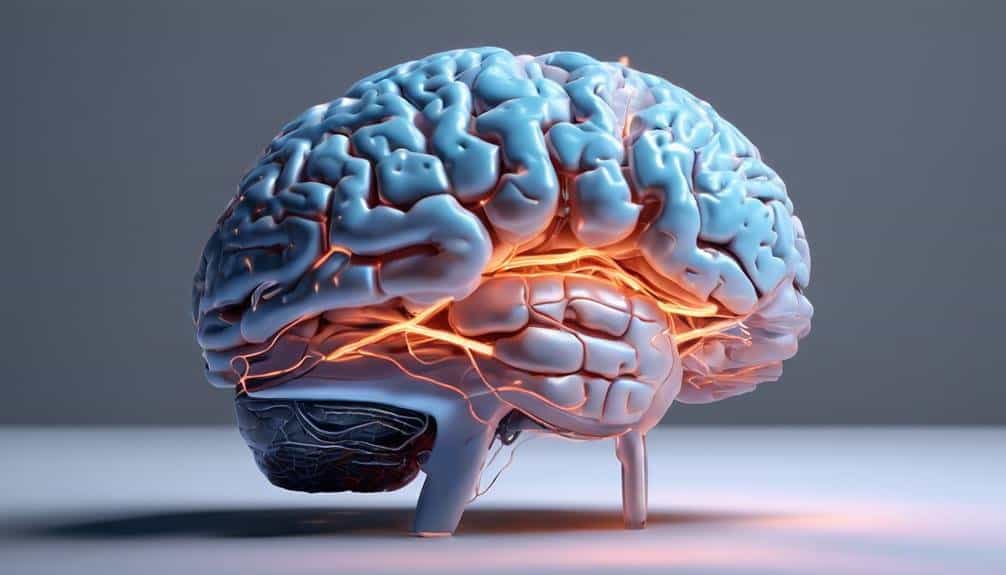The Science of Habit Formation: AI Insights
Imagine effortlessly reaching for a cup of coffee each morning without a second thought, just like your usual routine before starting work.
Have you ever wondered how artificial intelligence is deciphering the intricate patterns behind your habits? Discover how AI not only decodes habit loops but also offers fascinating insights into behavior prediction and habit change strategies.
Unravel the science of habit formation intertwined with AI's analytical prowess, shedding light on the inner workings of our daily routines.
Key Takeaways
- AI optimizes habit loop analysis for tailored interventions.
- Personalization enhances habit formation success rates.
- Data-driven insights boost behavior modification strategies.
- Environmental cues play a crucial role in habit shaping.
The Power of Neural Pathways
Understanding the intricate network of neural pathways in the brain is essential in comprehending the mechanics behind habit formation. Neural plasticity, the brain's ability to reorganize itself by forming new neural connections, plays a pivotal role in this process. When you repeatedly engage in a specific behavior, whether it's exercising or snacking, neural pathways associated with that behavior become stronger and more efficient. This phenomenon is the foundation of habit formation.
Studies have shown that habits are deeply ingrained in these neural pathways, making them automatic responses to certain cues or triggers. As you consistently perform a behavior, the corresponding neural pathways undergo changes, reinforcing the habit loop. This highlights the importance of neural plasticity in shaping our routines and behaviors.
Understanding Behavioral Triggers
Identifying triggers is essential in understanding habit formation. By pinpointing what prompts specific behaviors, you can unravel the intricate web of habits.
Exploring trigger impact and response patterns will provide valuable insights into behavior modification strategies.
Trigger Identification Methods
By examining patterns in your daily routines, you can pinpoint specific triggers that prompt certain behaviors. Understanding these triggers is vital for effective habit tracking and modification.
Here are three methods to identify triggers and enhance self-awareness:
- Journaling: Maintain a habit journal to record your actions, emotions, and surroundings before and after a behavior occurs. This can help you uncover hidden triggers and patterns.
- Self-reflection: Take time to reflect on your habits and behaviors daily. Ask yourself what led to a particular action or behavior, helping you identify the triggers that prompt these actions.
- Experimentation: Try altering your environment or routine to observe changes in your behavior. This can provide valuable insights into the triggers influencing your habits.
Impact of Triggers
Uncovering the influential role of triggers in shaping behavior patterns requires a keen examination of the environmental and emotional stimuli that precede specific actions. Understanding trigger response is essential in habit loop analysis, as it sheds light on how certain cues prompt habitual behaviors. Triggers can be categorized into different types such as external, internal, positive, negative, and sensory triggers. By analyzing trigger patterns, it becomes possible to predict behavior and implement strategies for habit formation or modification. This data-driven approach allows for a more precise understanding of individual responses to various triggers, enabling the development of targeted interventions for habit change. The table below illustrates the different types of triggers and their impact on habit formation.
| Types of Triggers | Description |
|---|---|
| External | Environmental stimuli |
| Internal | Emotional cues |
| Positive | Encouraging triggers |
| Negative | Discouraging triggers |
| Sensory | Triggered by senses |
Behavioral Response Patterns
To gain a thorough understanding of habit formation, it's imperative to explore the intricate behavioral response patterns that underlie the influence of various triggers. When delving into the domain of habitual decision making, cognitive behavioralism plays a pivotal role. Here are three key insights to take into account:
- Antecedents: These are cues that trigger your behavior, such as time of day, location, or emotional state.
- Routine: The actual behavior or habit that's performed in response to the trigger.
- Rewards: The positive reinforcement or benefit that reinforces the habit loop, making it more likely to be repeated.
AI's Role in Habit Loop Analysis
In modern habit research, artificial intelligence greatly enhances habit loop analysis by swiftly identifying patterns and correlations within vast datasets. AI analytics play a vital role in habit loop transformation, where machine learning algorithms sift through immense amounts of behavioral data to uncover hidden connections. By leveraging AI, researchers can gain deeper insights into the triggers, routines, and rewards that form habit loops.
AI analytics tools excel at processing complex datasets, allowing for a more thorough understanding of habit formation. These tools can detect subtle patterns that may not be immediately apparent to human analysts, enabling a more detailed analysis of habit loops. Additionally, AI systems can quickly adapt to new data inputs, continuously refining their analyses and predictions based on the latest information available.
Through habit loop transformation driven by AI, researchers can develop more effective strategies for habit intervention and behavior change. By harnessing the power of artificial intelligence in habit loop analysis, researchers can open up new possibilities for understanding and shaping human habits.
Uncovering Habit Formation Patterns
By analyzing extensive behavioral datasets, you can discern intricate patterns that illuminate the process of habit formation. This data-driven approach provides valuable insights into habit formation strategies and the workings of psychological habit loops, enhancing the effectiveness of AI applications in this field.
Here are three key points to take into account:
- Behavioral Triggers: Data analysis reveals that certain cues or triggers consistently precede the repetition of a habit. Understanding these triggers can help individuals and AI systems anticipate and modify habits effectively.
- Reinforcement Mechanisms: By examining patterns in rewards or punishments following habit execution, we can ascertain the reinforcement mechanisms that strengthen habit loops. This knowledge can inform the development of strategies to promote or alter behaviors.
- Contextual Influences: Data-driven insights also shed light on how environmental or social factors impact habit formation. Recognizing these influences can guide individuals and AI algorithms in creating conducive environments for habit building or breaking.
Through the exploration of these habit formation patterns, we can refine our understanding of behavior change processes and optimize interventions for personal development and well-being.
Leveraging Data for Behavior Prediction
Leveraging behavioral data analytics can enhance predictive models for understanding and forecasting human behaviors with precision and depth. By analyzing patterns and trends in behavioral data, organizations can gain valuable insights into consumer preferences, habits, and decision-making processes. Behavioral analytics enables the identification of key indicators that drive specific behaviors, allowing for more accurate predictions of future actions.
When it comes to predictive modeling, integrating behavioral data is vital for building robust algorithms that can anticipate and adapt to changing behaviors. The table below illustrates how different types of behavioral data can be utilized for predictive modeling:
| Type of Behavioral Data | Description | Example |
|---|---|---|
| Demographic | Information about individuals such as age, gender, and location | Age: 25, Gender: Female, Location: New York |
| Psychographic | Data related to personality traits, values, interests, and lifestyles | Personality Type: Introvert, Value: Sustainability, Interest: Travel |
| Behavioral | Actions and interactions exhibited by individuals | Purchase History: Bought Laptop, Clicked on Tech News, Visited Website Daily |
Personalization Through AI Algorithms
Analyzing behavioral data allows for the development of personalized experiences through AI algorithms that tailor recommendations and interactions based on individual preferences and behaviors. This level of personalization through AI insights enables a deeper understanding of user needs and desires, fostering a more engaging and effective user experience. Here are some ways in which this can impact behavior modification through AI algorithms:
- Enhanced Engagement: Personalized recommendations drive increased user engagement by providing relevant content that resonates with individual interests.
- Improved User Satisfaction: AI insights lead to behavior modification by offering tailored solutions that align with user preferences, ultimately enhancing satisfaction levels.
- Efficient Habit Formation: By leveraging personalized recommendations and AI algorithms, individuals can more effectively establish new habits that positively impact their lives.
Through the power of personalization and AI-driven insights, behavior modification becomes a more seamless and impactful process, shaping habits in a way that's attuned to individual needs and preferences.
Breaking Down Habit Reinforcement
Understanding the intricate mechanisms behind habit reinforcement is important for developing effective behavior modification strategies. Habit reinforcement involves the process of strengthening a habit through various strategies. When considering habit extinction, where undesired habits are eliminated, reinforcement strategies play a pivotal role in facilitating this process.
One effective reinforcement strategy is known as 'extinction burst,' where the habit is no longer reinforced, leading to a temporary increase in the behavior before it diminishes. This phenomenon highlights the importance of consistency in breaking down habits.
Reinforcement strategies can also involve providing alternative behaviors to replace the undesired habit. By offering a substitute behavior that fulfills a similar need, individuals can redirect their habits towards more positive outcomes. Additionally, reinforcement through positive feedback and rewards can further solidify new habits.
Environmental Influence on Habits
The impact of surroundings on habit formation is a critical factor that greatly influences behavioral patterns. Environmental cues play a significant role in shaping our habits.
Here are three key ways environmental cues impact habit formation:
- Visual Cues: The visual stimuli present in your environment can act as triggers for certain habits. For example, seeing a snack on the kitchen counter might prompt you to indulge even if you're not hungry, reinforcing the habit of mindless eating.
- Spatial Cues: The layout of your environment can also influence habit formation. For instance, if your workout clothes are easily accessible, you're more likely to exercise regularly due to the environmental cue of convenience.
- Social Cues: The people you surround yourself with can have a profound impact on your habits. If your social circle values healthy eating, you're more likely to adopt similar habits, showcasing the powerful influence of environmental impact on habit loops.
Understanding how environmental cues affect habit formation is essential in designing environments that support positive behavioral changes.
The Neurobiology of Routine Formation
When it comes to forming routines, the brain's habit circuits play a pivotal role in shaping behavior.
Dopamine, a neurotransmitter linked to reward and pleasure, reinforces these routines, making them more likely to be repeated.
Through the development of neural pathways, habits become ingrained and automatic, impacting your daily actions and decisions.
Brain's Habit Circuits
With each routine you establish, your brain's habit circuits wire together, forming neural pathways that streamline the process and make it more automatic over time. Through neuroplasticity research, scientists have uncovered fascinating insights into the brain's ability to adapt and form habits. The habit loop dynamics play a vital role in this process, involving cues, routines, and rewards that shape your behavior. Here are three key points to ponder:
- Neural connections strengthen with repetition, reinforcing the habit loop.
- Dopamine release reinforces behaviors linked to rewards.
- Over time, habits become more ingrained, requiring less conscious effort to perform.
Understanding how your brain forms habits can empower you to cultivate positive routines effectively.
Dopamine and Routines
Repeated engagement in routines triggers the release of dopamine, a neurotransmitter associated with reward and reinforcement in the brain. This release of dopamine is essential in cementing habits. Studies have shown that dopamine spikes occur not only when a reward is received but also in anticipation of the reward.
When it comes to daily rituals, the brain starts associating certain activities with pleasure, prompting the release of dopamine even before the task is completed. This anticipation reinforces the habit loop, making it more likely for you to continue the routine. Understanding the role of dopamine in routine formation sheds light on why certain behaviors become ingrained in our daily lives and how the brain seeks rewards to solidify these patterns.
Neural Pathway Development
Neurobiological studies reveal that habit formation involves the intricate development of neural pathways in the brain, highlighting the structural changes that underlie the solidification of routines. These changes are pivotal in understanding how habits are formed and maintained.
Key processes involved include:
- Synaptic Plasticity: The brain's ability to reorganize itself by forming new synaptic connections, essential for encoding habits through repetition.
- Memory Consolidation: The process by which the brain stabilizes a memory trace after initial acquisition, playing a significant role in habit formation and retention.
- Cognitive Restructuring: Refers to the reshaping of neural pathways through conscious effort, necessary for breaking old habits and forming new ones efficiently.
Understanding these mechanisms sheds light on the neurobiology of routine formation and the potential for cognitive change.
AI-Driven Habit Change Strategies
AI-Driven Habit Change Strategies leverage sophisticated algorithms to analyze behavior patterns and tailor personalized interventions for individuals seeking to modify their habits. By employing AI-driven habit tracking and intervention, these strategies can offer a data-driven approach to habit formation. Habit change algorithms play an important role in optimizing the intervention process by identifying key triggers and rewards that drive habit loops.
Through AI, individuals can receive tailored suggestions and feedback based on their unique behavioral data. These algorithms can analyze vast amounts of information to provide personalized recommendations that are more likely to lead to successful habit modification. By continuously learning and adapting to an individual's habits, AI-driven strategies can offer ongoing support and guidance, making behavior change more achievable.
The optimization capabilities of AI allow for real-time adjustments to intervention strategies, increasing their effectiveness. By leveraging the power of AI in habit change efforts, individuals can benefit from personalized and data-backed approaches that enhance their chances of successfully forming new habits.
Conclusion
As you navigate the intricate web of habit formation, remember that your brain is constantly forging new neural pathways. By understanding the behavioral triggers that drive your routines, AI insights offer a unique perspective on habit loops.
Leveraging data to predict behaviors and analyzing environmental influences can lead to powerful habit change strategies. Embrace the science of habit formation, and watch as your routines transform into a symphony of orchestrated movements, guided by the precision of AI technology.







